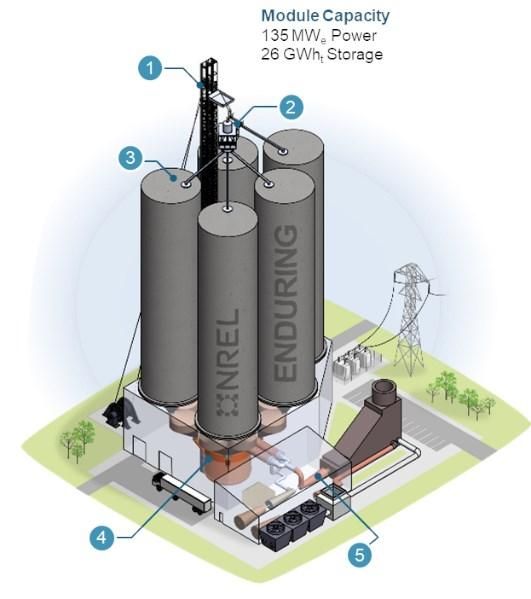Optimizing State of Charge and Parameters in Lithium-Ion Batteries – Bioengineer.org

Report on Advancements in Lithium-Ion Battery Optimization and a Contribution to Sustainable Development Goals
Executive Summary
A study by Wu and Li, published in Ionics, introduces a multi-matrix optimization framework for enhancing State of Charge (SoC) estimation and parameter identification in lithium-ion batteries. This technological advancement is pivotal for improving battery efficiency, longevity, and safety. The research directly supports the achievement of several United Nations Sustainable Development Goals (SDGs) by fostering innovation in clean energy storage, which is fundamental for sustainable infrastructure, climate action, and responsible consumption.
Research Overview: A Novel Framework for Battery Management
The Challenge in Battery Performance
Accurate estimation of a battery’s SoC is critical for performance and safety but is often compromised by operational variables such as temperature and discharge rates. Traditional methods have struggled to provide reliable estimations under dynamic conditions, limiting the potential of energy storage systems.
Methodology and Key Innovations
The research proposes a holistic approach that simultaneously addresses SoC estimation and parameter identification through a multi-matrix optimization technique. Key innovations include:
- Dual-Focus Optimization: Unlike previous studies, this method concurrently optimizes SoC estimation and identifies core battery parameters for a more comprehensive understanding of battery behavior.
- Machine Learning Integration: The framework incorporates data-driven algorithms to predict performance trajectories, enhancing the adaptability and intelligence of battery management systems.
- Empirical Validation: The proposed methodology was rigorously tested across various battery types and conditions, confirming its robustness and practical applicability.
Alignment with Sustainable Development Goals (SDGs)
SDG 7: Affordable and Clean Energy
The research provides a critical technological enabler for the widespread adoption of renewable energy sources.
- Improved battery efficiency and reliability are essential for storing intermittent energy from solar and wind, ensuring a stable and continuous supply of clean energy.
- By enhancing energy storage systems, this innovation facilitates the transition away from fossil fuels, making clean energy more accessible and affordable.
SDG 9: Industry, Innovation, and Infrastructure
This study represents a significant innovation that strengthens the technological capabilities of the energy and transport industries.
- It promotes the development of resilient and sustainable infrastructure by improving the core technology behind grid-scale energy storage and electric mobility.
- The advancement fosters industrial progress towards cleaner and more efficient technological processes.
SDG 11: Sustainable Cities and Communities
The findings have a direct impact on the development of sustainable transportation systems within urban environments.
- By providing more accurate SoC estimation, the technology helps mitigate “range anxiety” in electric vehicles (EVs), encouraging their adoption and reducing urban air pollution.
- Reliable EV batteries contribute to creating cleaner, safer, and more sustainable urban transport networks.
SDG 12: Responsible Consumption and Production
The optimization of battery performance promotes more sustainable consumption patterns by extending product lifecycles.
- Enhancing battery longevity reduces the frequency of replacement, thereby minimizing electronic waste and lessening the demand for raw material extraction.
- Efficient battery management aligns with principles of circular economy and sustainable resource management.
SDG 13: Climate Action
The core contribution of this research is its potential to accelerate climate change mitigation efforts.
- By enabling effective integration of renewable energy and promoting the electrification of transport, this technology directly supports the reduction of global greenhouse gas emissions.
- It provides a foundational tool for building a low-carbon energy future.
Broader Implications and Future Outlook
Impact on Key Sectors
The application of this research extends across multiple high-impact industries:
- Electric Vehicles: Manufacturers can develop more efficient, reliable, and safer EVs, boosting consumer confidence and market growth.
- Renewable Energy: Grid operators can more effectively manage energy from variable sources, enhancing grid stability and reliability.
- Consumer Electronics: The lifespan and performance of batteries in everyday devices can be significantly improved.
Future Research Directions
The principles of multi-matrix optimization detailed in this study offer a promising avenue for future exploration. The framework’s applicability could be extended to other energy storage technologies, including solid-state and flow batteries, potentially leading to a paradigm shift in energy management and contributing further to global sustainability targets.
Analysis of Sustainable Development Goals (SDGs) in the Article
1. Which SDGs are addressed or connected to the issues highlighted in the article?
- SDG 7: Affordable and Clean Energy – The article focuses on improving battery technology, which is essential for storing energy from renewable sources and powering clean transportation.
- SDG 9: Industry, Innovation, and Infrastructure – The research represents a significant scientific innovation in energy storage technology, contributing to more sustainable and resilient infrastructure.
- SDG 11: Sustainable Cities and Communities – The advancements discussed directly support the development of electric vehicles, which are key to creating sustainable transport systems in urban areas.
- SDG 12: Responsible Consumption and Production – By enhancing the longevity and efficiency of batteries, the research promotes more sustainable use of resources and reduces waste.
- SDG 13: Climate Action – The technology described is crucial for the transition away from fossil fuels by enabling the widespread adoption of renewable energy and electric vehicles, thereby mitigating climate change.
2. What specific targets under those SDGs can be identified based on the article’s content?
-
SDG 7: Affordable and Clean Energy
- Target 7.2: Increase substantially the share of renewable energy in the global energy mix. The article states that enhanced battery performance is vital for “managing the erratic nature of renewable energy generation” like solar and wind, thus facilitating a “smoother transition to sustainable energy solutions.”
- Target 7.3: Double the global rate of improvement in energy efficiency. The research’s primary goal is to “enhance the longevity and efficiency of batteries,” which directly contributes to overall energy efficiency in storage and applications like electric vehicles.
-
SDG 9: Industry, Innovation, and Infrastructure
- Target 9.4: Upgrade infrastructure and retrofit industries to make them sustainable, with increased resource-use efficiency and greater adoption of clean and environmentally sound technologies. The development of advanced battery management systems is a clean technology that upgrades energy and transport infrastructure.
- Target 9.5: Enhance scientific research, upgrade the technological capabilities of industrial sectors… encouraging innovation. The article describes a “novel approach,” “cutting-edge methodology,” and “innovative work” in battery technology, which is a direct example of enhancing scientific research for industrial application.
-
SDG 11: Sustainable Cities and Communities
- Target 11.2: Provide access to safe, affordable, accessible and sustainable transport systems for all. The article explains that its findings can help create “safer and more reliable electric transportation solutions,” which are a cornerstone of sustainable urban transport.
-
SDG 12: Responsible Consumption and Production
- Target 12.2: Achieve the sustainable management and efficient use of natural resources. The research aims to solve problems like “diminished battery life.” By extending battery longevity, it promotes more efficient use of the natural resources required for battery production.
-
SDG 13: Climate Action
- Target 13.2: Integrate climate change measures into national policies, strategies and planning. The technological advancements in battery storage are critical enablers for policies aimed at decarbonizing the energy and transport sectors, which are fundamental to climate action strategies.
3. Are there any indicators mentioned or implied in the article that can be used to measure progress towards the identified targets?
-
Indicators for SDG 7 Targets
- Indicator for Target 7.2: The article implies the measurement of grid stability when integrating renewable energy sources. Progress can be measured by the increased capacity of renewable energy that can be reliably integrated into the power grid thanks to improved energy storage systems.
- Indicator for Target 7.3: The article directly points to “battery performance,” “longevity,” and “efficiency” as key metrics. These can be measured through laboratory tests and real-world performance data of batteries using the new optimization techniques.
-
Indicators for SDG 9 Targets
- Indicator for Target 9.5: The existence of the research paper itself (“State of charge estimation and parameter identification of lithium-ion batteries based on multi-matrix optimization”) serves as an indicator of investment in research and development. Further indicators could be the number of patents filed or the adoption of these “advanced optimization techniques” in the industry.
-
Indicators for SDG 11 Targets
- Indicator for Target 11.2: The article mentions improving “vehicle performance” and addressing “range anxiety.” Therefore, measurable indicators would be the average range of electric vehicles, their market adoption rate, and user satisfaction metrics related to reliability and performance.
-
Indicators for SDG 12 Targets
- Indicator for Target 12.2: An implied indicator is the operational lifespan of lithium-ion batteries. Progress would be measured by an increase in the average service life of batteries, leading to a reduction in battery waste and a lower replacement rate.
-
Indicators for SDG 13 Targets
- Indicator for Target 13.2: While not directly stated, a high-level indicator is the reduction in greenhouse gas emissions from the transport and energy sectors. The successful implementation of the technology described would contribute to this reduction by making EVs and renewable energy more viable and efficient.
4. Summary Table of SDGs, Targets, and Indicators
| SDGs | Targets | Indicators |
|---|---|---|
| SDG 7: Affordable and Clean Energy | 7.2: Increase the share of renewable energy. 7.3: Improve energy efficiency. |
– Increased grid stability with integrated renewables. – Measurable improvements in battery longevity and efficiency. |
| SDG 9: Industry, Innovation, and Infrastructure | 9.4: Upgrade infrastructure with clean technologies. 9.5: Enhance scientific research and innovation. |
– Adoption rate of advanced battery management systems in industry. – Number of scientific publications and patents in energy storage. |
| SDG 11: Sustainable Cities and Communities | 11.2: Provide access to sustainable transport systems. | – Increased market share and average range of electric vehicles. – Reduction in urban air pollution from transport. |
| SDG 12: Responsible Consumption and Production | 12.2: Achieve sustainable management and efficient use of natural resources. | – Increase in the average operational lifespan of batteries. – Reduction in battery waste per capita. |
| SDG 13: Climate Action | 13.2: Integrate climate change measures into policies and planning. | – Reduction in greenhouse gas emissions from the energy and transport sectors. |
Source: bioengineer.org
What is Your Reaction?
 Like
0
Like
0
 Dislike
0
Dislike
0
 Love
0
Love
0
 Funny
0
Funny
0
 Angry
0
Angry
0
 Sad
0
Sad
0
 Wow
0
Wow
0



















































.jpg.webp?itok=0ZsAnae9#)


























